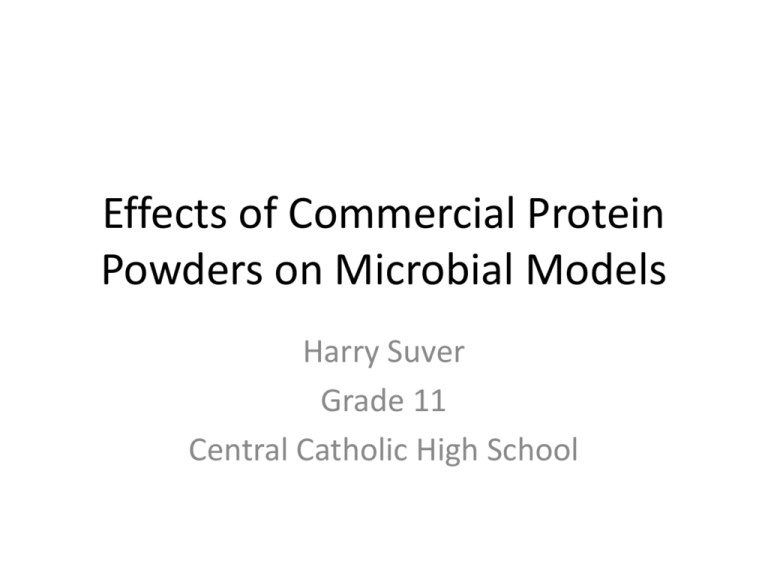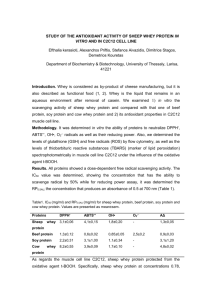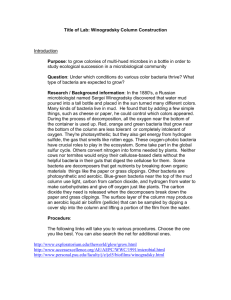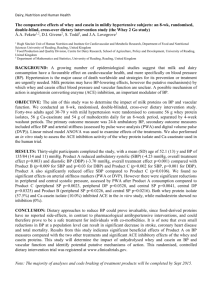Effects of Commercial Protein Powders on Microbial Life
advertisement

Effects of Commercial Protein Powders on Microbial Models Harry Suver Grade 11 Central Catholic High School Gram Staining • Invented by Hans Christian Gram • Is a method of differentiating bacterial species into two groups, Gram-positive and Gram-negative • Gram-positive bacteria have generally a single membrane (monoderm) surrounded by a thick peptidoglycan • Gram-negative bacteria generally possess a thin layer of peptidoglycan between two membranes • When stained, a Gram-positive bacteria results in a blue/violet color while Gram-negative results in light red/pink Gram(-) vs. Gram(+) Gram-negative Cell walls contains an extra layer of lipopolysaccharides for extra protection. Outer membrane protects bacteria from several antibiotics. Gram-positive Most pathogenic bacteria in humans are Gram (+) organisms. Simple cell wall. Some antibiotics work against the formation of the cell wall. Staphylococcus Epidermidis • Staph. species consisting of harmless skin-dwelling micro-organisms • Species of Staph. are commonly used in microbiological experiments because of variety of strain types within each species – each strain has different features and toxins • Gram-positive bacteria • Most strains are not pathogenic Escherichia coli • Major cause of food-borne illness • Consumption of undercooked meats • Consumption of contaminated vegetables or unpasteurized milk • Also resides in fecal matter • Most studied bacteria in the world and very commonly used in the lab • Resides in the digestive tract of animals • Not all strains of E.coli can result in sickness or disease • Is a Gram-negative bacteria Whey Protein • GNC Pro Performance 100% Whey Protein • Whey protein is a mixture of globular proteins isolated from whey, the liquid material created as a by-product of cheese production. • Whey protein is commonly marketed and ingested as a dietary supplement, and various health claims have been attributed to it in the alternative medicine community. Soy Protein • GNC Super Foods 100% Soy Protein • protein isolated from the soybean. • Made from soybean meal that had been dehulled and defatted Purpose • The purpose of this experiment was to see if protein powder had significant effects on the growth of microbial models Hypothesis • Null Hypothesis- The protein powder will not have a significant effect the growth of the bacteria • Alternate Hypothesis- The protein powder will have a significant effect on the bacteria and will cause more colonies to grow than the control groups Materials • E.coli • Staph. E. • GNC pro performance Whey Protein • GNC Soy Protein • LB media (.5% yeast extract, 1% tryptone, 1% sodium chloride) • Agar plates • Spreader bars • Bunsen Burner • Vortex • • • • • • • • Incubator Micropipettes Sterile pipette tips Sterile dilution fluid ([SDF] (10mM KH2PO4, 10mM K2HPO4, 1mM MgSO4, .1mM CaCl2, 100mM NaCl) Sterile test tubes Test tube rack Ethanol Matches Procedure 1. Bacteria (E.coli and Staph. E.) were grown overnight in sterile LB Media. 2. Samples of the overnight cultures were added to fresh media in a sterile sidearm flask. 3. The cultures were placed in an incubator (37°C) until a density of 50 Klett spectrophotometer units was reached. This represents a cell density of approximately 10⁸ cells/mL. 4. The cultures were diluted in sterile dilution fluid to a concentration of approximately 10⁵ cells/mL. 5. Solutions were made up in sterile test tubes using sterile fluid and variable. 6. 0.1mL. Of the cell cultures were added to the solutions which brought them to a total volume of 10mL. 7. Solutions were pipetted onto LB plates using a micro-pipette. 8. Spreader bars were sterilized and used to spread solutions on the plates. 9. Plates were put in an incubator set at 37 degrees Celsius for 24 hours. 10. Colonies were counted, data was recorded, results were analyzed. Concentrations in Tubes CONTROL 5% 10% STERILE FLUID VARIABLE 9.9 mL 7.9 mL 7.9 mL 0.0 mL 2.0 mL (of 25% stock) 2.0 mL (of 50% stock) BACTERIA 0.1 mL 0.1 mL 0.1 mL TOTAL VOLUME 10 mL 10 mL 10 mL 5 replicates for each group Stat Analysis ANOVA • Shows if there is any variations between the mean of 2 or more variable groups Alpha=.05 Dunnetts Test • Shows the variation between a control group and an experimental groups T crit= 3.03 Staph with Soy Protein 170 165 P-value = 0.037219 = Significant Number of Colonies 160 155 150 145 140 135 130 125 Control 5% 10% Dunnett's Test(Staph w/ Soy) Concentration T-value Significance 5% 1.207 Not Significant 10% 3.34 Significant 180 160 Staph with Whey Protein P-value = .116984 = Not Significant 140 Number of Colonies 120 100 80 60 40 20 0 Control 5% 10% Dunnett’s Test (Staph w/Whey) Concentration T-value Significance 5% -0.99281 Not Significant 10% 1.2264 Not Significant E.Coli with Soy Protein 450 400 P-value = 0.003653 = Significant Number of Colonies 350 300 250 200 150 100 50 0 Control 5% 10% Dunnetts Test (E.coli w/ Soy) Concentration T-value Significance 5% 3.2442 Significant 10% 4.4968 Significant E.Coli with Whey Protein 350 340 P-value = 0.016782 = Significant Number of Colonies 330 320 310 300 290 280 270 Control 5% 10% Dunnetts Test (E.coli w/ Whey) Concentration T-value Significance 5% -0.5841 Not Significant 10% 3.8646 Significant Conclusion • The Null Hypothesis can be partially rejected, and the Alternate Hypothesis can be partially accepted. • Soy protein had significant effects on both bacterial models at all concentrations and caused more colonies to grow. • Whey protein did not have significant effects on either bacterial model at any concentration. • While on some occasions the 5% groups had less colonies than the control groups, they had colonies that were larger in size Limitations • Did not have access to any other model organisms. • Lag time between counting of colonies Continuations • Experiment could be expanded to test protein powder on stem cells or algae. • Could compare protein powder’s effectiveness to growth hormones and natural animal proteins. ANOVA (Staph w/ soy) SUMMARY Groups Column 1 Column 2 Column 3 ANOVA Source of Variation Between Groups Within Groups Total Count 5 5 5 SS 376.1333 Sum Average Variance 700 140 62.5 725 145 62.5 761 152.2 3.7 df MS F P-value F crit 2 188.0667 4.383838 0.037219 3.885294 514.8 12 890.9333 14 42.9 ANOVA (Staph w/ whey) SUMMARY Groups Column 1 Column 2 Column 3 ANOVA Source of Variation Between Groups Within Groups Total Count Sum 5 5 5 SS 3782.8 8798.8 12581.6 Average Variance 700 140 20.5 615 123 1678 809 161.8 501.2 df MS 2 1891.4 12 733.2333 14 F 2.579534 P-value 0.116984 F crit 3.885294 ANOVA (E.coli w/ soy) SUMMARY Groups Column 1 Column 2 Column 3 ANOVA Source of Variation Between Groups Within Groups Total Count 5 5 5 SS 15257.2 9855.2 25112.4 Sum Average Variance 1530 306 348.5 1685 337 698 1918 383.6 1417.3 df MS 2 P-value F crit 7628.6 9.288822 0.003653 3.885294 12 821.2667 14 F ANOVA (E.coli w/ whey) SUMMARY Groups Column 1 Column 2 Column 3 ANOVA Source of Variation Between Groups Within Groups Total Count 5 5 5 SS 4813.333 4930 9743.333 Sum Average Variance 1530 306 305 1480 296 247 1690 338 680.5 df MS F P-value F crit 2 2406.667 5.858012 0.016782 3.885294 12 410.8333 14 References • CentralCatholichs.com/biology • http://www.gnc.com/home/index.jsp






